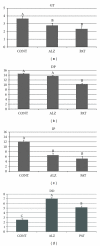The lyon clinical olfactory test: validation and measurement of hyposmia and anosmia in healthy and diseased populations
- PMID: 22046188
- PMCID: PMC3199207
- DOI: 10.1155/2011/203805
The lyon clinical olfactory test: validation and measurement of hyposmia and anosmia in healthy and diseased populations
Abstract
The LCOT is a self-administered test designed to assess olfactory deficits. Altogether, 525 subjects contributed to the validation. Elderly participants were well represented in this sample. In a validation study (study 1), 407 healthy and 17 anosmic volunteers between 15 and 91 years of age underwent threshold, supraliminal detection, and identification testing. Cutoff values for normosmia and hyposmia were calculated and applied in a second study in a group of patients with smell complaints and in a group of Alzheimer patients with age-matched controls. Incidence of smell deficit was estimated at 5.6% in the healthy population of study 1, and at 16% in the elderly control group of study 2. Assessment of the ability of each subtest to discriminate between groups showed that LCOT is relevant to differentiating between perception and identification deficits and between Alzheimer's and hyposmic patients.
Figures


References
-
- Rouby C, Pouliot S, Bensafi M. Odor hedonics and their modulators. Food Quality and Preference. 2009;20(8):545–549.
-
- Nordin S, Brämerson A. Complaints of olfactory disorders: epidemiology, assessment and clinical implications. Current Opinion in Allergy and Clinical Immunology. 2008;8(1):10–15. - PubMed
-
- Brämerson A, Nordin S, Bende M. Clinical experience with patients with olfactory complaints, and their quality of life. Acta Oto-Laryngologica. 2007;127(2):167–174. - PubMed
-
- Murphy C, Schubert CR, Cruickshanks KJ, Klein BEK, Klein R, Nondahl DM. Prevalence of olfactory impairment in older adults. JAMA. 2002;288(18):2307–2312. - PubMed
-
- Hummel T, Kobal G, Gudziol H, Mackay-Sim A. Normative data for the “Sniffin’TM Sticks” including tests of odor identification, odor discrimination, and olfactory thresholds: an upgrade based on a group of more than 3,000 subjects. European Archives of Oto-Rhino-Laryngology. 2007;264(3):237–243. - PubMed
LinkOut - more resources
Full Text Sources

